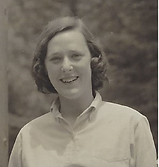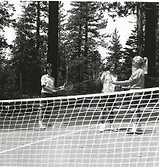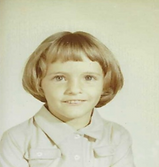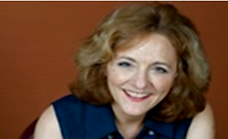Camp Memories & Reviews
Memories

1946

1947
For two summers, I was a camper at Talawanda camp for girls, and I was able to take pack trips into the backcountry and really see the beauty that surrounds this great lake.
Camp Talawanda holds a special place in Lake Tahoe’s history and in my heart. I understand it was likely the first all-girls camp in the Basin, which is indeed notable. But, having attended as a young woman myself, I can attest first-hand that Talawanda was so much more. There were few places like it, where city girls like me could come together to ride horses, play sports, jump into the Lake without a care, learn how to rough it in the woods, laugh late into the night under the stars, and so much more. It was empowering, enriching, and joyful. It’s one of the reasons I, and so many other young women, fell in love with Lake Tahoe for a lifetime.
Camp Talawanda is well worth commemorating. I believe people for generations to come will be delighted and inspired to know more about its rich history, its contributions to Lake Tahoe’s legacy, and the women whose lives it helped transform.
-Dianne Goldman (Feinstein)
U.S. Senator

CAMP TALAWANDA
Was it Janie’s parents or was it my mom who came up with the idea to send their two little girls to a girls’ camp in Lake Tahoe? It must have been no earlier than 1945, because we were still in Sparks, Nevada then. I know, because in April of that year, we watched the American flag being lowered to half-mast to
commemorate the death of President Roosevelt.
Beginning very likely in 1946, my Camp Talawanda experience was transformative. I was consumed with camp and camp lore and camp tradition and camp values and camp friends as a major part of my growing up. From our first two years in Cedar, a lodge with double-decker bunkbeds and a big fireplace at one end and a couple of years in Hemlock, a lodge with separate rooms, each with two beds and an up-ended orange crate between them for flashlight, toiletries and the like (Janie and I flipped coins to see who got the top and who got the bottom), we moved on to Nook, a tent platform with beds outdoors in a circle surrounding a fire pit. The
last stop was for senior campers: Pine, again, a lodge with separate rooms.
Well, not the last stop. Because some of us were chosen to return the following year – at age 16 to be assistant counselors. I was among them and for the next five years graduated to senior counselor and finally, assistant director, a job I held for the last three years of my college career. A note on this: the director of the camp, Wilma (Birch) McFarland, was aware – I know not how – that my mother was struggling financially, and she very generously paid me a salary of $600 – a huge sum for a summer job in those days - for my role as assistant director. This sum came close to paying all of my college expenses (disclaimer: tuition at UC Berkeley was free and incidental charges were $45 for my freshman year, and by the time I was a senior, it had climbed to an astounding $84.
But why devote two pages to Camp Talawanda? There is plenty of nostalgia, of course: the swings and big CAMP TALAWANDA sign at the entrance to the camp; the flagpole surrounded by white pebbles, where all the campers/counselors stood in a circle for the pledge of allegiance, announcements, and fingernail inspection; the huge dining hall with tables assigned to each lodge and the sounds of “Here We Sit Like Birds in the Wilderness …. Waiting for our Food to Come …”; the campfire and rickety wooden stage with the heavy cotton curtain strung on a wire barely able to hold its weight; The End-of-Camp Red/White/Blue team competition and the prize of a whole watermelon to the winning team; Sunday worship when we all wore white and sang, “Come, come, come to the church in the wild wood …. Come to the church in the dale ….”; and Campers be Counselors Day when the tables were turned, and some lucky camper got to blow Birch’s whistle.
Here’s why: This was a girls’ camp. The director was a woman; the counselors were all female; and, unlike the co-ed public school which I attended, girls umpired; girls were captains of teams; they lead the singing at campfire; they directed and produced the plays. When awards were handed out on Sunday, they were all awarded to girls. How affirming is that? And what a difference did that make in my life’s trajectory?
Upon reflection, I believe that the Talawanda experience planted the seeds for my ready acceptance, no – embrace -of the values of what is known as the Second Wave of Feminism, the women’s liberation movement which some say was ignited by Betty Friedan when she published “The Feminine Mystique” in 1963. It took a while, however.
I loved my college years from 1955-1959. I loved being on campus; I worked hard and did well and thought to myself how wonderful it would be to one day marry a
professor so I could continue to enjoy an academic environment. It never occurred to me that I might BE that professor, not just marry one. Upon my graduation from college in 1959, one of my professors suggested I continue my studies in graduate school, but I was eager to move on to new adventures.
So, while Friedan was busy writing her book, I was hitch-hiking in Europe. While it was in the final editing stages, I was newly married and living in Cheyenne. On the date of the release of “The Feminine Mystique,” we were preparing to live and work for two years in a Tibetan Refugee Settlement in Northern India. The movement was taking off exponentially during our five years living in Indonesia. But I was utterly unaware that there were rustlings among women seeking “liberation” during
those years.
Upon my return to the states in 1972, however, “Women’s Lib” was everywhere, and I was an enthusiastic and committed receptacle for what that would mean for me
personally, for my daughter, and for women throughout the land.
Thank you, Talawanda, for preparing the way.
-Susie Fisher (Purdy)
Camper – Counselor – Co-Director


From Camper to Village Counselor and Riding Instructor – 1951-1957
My best friend, Marigay, went to Talawanda in 1949 and we both convinced my mother that I simply had to go the next year. Except that next year, 1950, is when Birch also ran a camp at the ranch. We both were horse crazy, so we went there instead.
The next year, 1951, I went to Talawanda for two weeks that pretty well changed my life. The next year, 1952, my folks said it was too expensive, and I couldn’t go to camp. When I told Birch she did what I think she must have done for quite a few others and told me I could come for free for as long as I liked. Somehow, I think she must have known just how much Talawanda had come to mean to me. Trying not to be greedy, but being very greedy indeed, I said, “gosh, how about five weeks?”
At some point she asked us Pine kids if anyone wanted to get up early and help set up for breakfast. I couldn’t get my hand up fast enough. I was so happy to feel that I could do something to make up even a tiny bit for Birch’s great kindness to me. Afterwards, she said very quietly, “I thought you might.” She was so very tactful in every way and I was so grateful that I could do even a little bit.
-Maurine “Bunny” Robinson

From Camper

to Senior Counselor

Sally Leahy, Senior Counselor, Tennis Instructor
Summer in San Francisco can get very dreary. Our family grew up in the foggiest part of the city. We five girls entertained one another for the most part, but the weather was not conducive to a lot of outdoor activity. Luckily our parents got wind of a girls’ camp in the Tahoe area called Camp Talawanda. They signed up the first four of us, for two weeks. At our request and begging they extended the two weeks to six weeks that first year and every year thereafter. Our younger sister joined us when she was old enough to attend.
We departed for camp from the Greyhound bus station in San Francisco. The camp was located in the woods near the Kings Beach area of Lake Tahoe. Off highway 267 we took a left turn onto North Road. It was an unpaved road that had ups and downs, so to speak. One was called the
“Big Dipper” and another was called the “Little Dipper.”
Camp Talawanda had six lodges for the girls divided by age—Cedar, Hemlock, Nook, Chipmunk, Village and Pine. Campers in two of the lodges slept outside under the stars with a large tent structure for changing. During those years there did not seem to be a bear problem as there is today.
Each lodge had to pass inspection every morning after breakfast. If your lodge passed inspection for so many days, your group could vote on a special outing called a “sneak”. Some of the favorites outings were a frosty run, a Jimboy’s Taco visit, a round of miniature golf, just to name a few of the choices.
After inspection, we campers gathered for “Colors” which consisted of the raising of the flag, the pledge of allegiance and the day’s announcements. From there we went off to our various chosen activities.
I recall that each camper chose two activities to participate in before lunch. Choices included crafts, drama, tennis, badminton, archery and riding taught by a skilled counselor.
Lunch was served in a large dining hall with tables for each lodge to sit together. After lunch you could buy something at the little store, either a treat or necessities such as chapstick, toothpaste, stamps, postcards and the like. Soon thereafter, it was rest hour. It was truly a quiet time to be on your bunk to rest, write letters, or read.
Every Sunday the entire camp took a walk into the woods for an assembly. Birch, the Camp Director, would read a psalm or give a spiritual talk after which weekly awards were announced. We felt highly honored to receive such recognition for that week.
After lunch it was time for swimming. We would hop on the large open slat truck to drive to the lake for a swim. We would either go to the pier at the camp’s cabin in Tahoe Vista or be driven to a special beach for that afternoon. Various camp songs would be sung in the truck as we were driven to and from our excursions around Kings Beach, Tahoe Vista and nearby areas. It was quite a sight to behold, a large red truck filled with girls singing songs. That would never be allowed today! No seatbelts in sight, much less seats to sit in.
After returning to camp wet and chilly, many campers would head to the bathhouse for a hot shower and warm clothes. We had free time to hang out, play tetherball, ping pong, croquet, work on a craft project or whatever we chose.
Upon hearing the cowbell we would all go down to the dining hall for dinner. You would try to be on time so that you were not sung to by the campers who had already arrived on time. If you had elbows on the table you might also be pointed out with song.
After dinner it was time to assemble at the very large campfire. A counselor led us in various camp songs. Often the drama club would put on a skit or play to entertain us all. At the close of the evening we would stand up in a circle, lock arms and sing “Day is Done.”
Beyond the usual daily routine, there were many events that made camp even more fun and interesting. There were parties every Saturday night with some sort of theme. A favorite game during these parties was called “You must pass the shoe.” There was one less shoe than the number of players and the person without a shoe at the end of each chorus was eliminated. Kind of a take on musical chairs.
A Christmas party was always held on the last Saturday in July. There was “camper be leader day” when each counselor would choose a camper to be that particular counselor for that day. There were overnight horse pack trips and overnight hikes, Sand Harbor beach days, ice skating days at Squaw Valley, history outings to Donner Lake to hear the story of the Donner party, outings to silver mining towns, ghost towns and more. On special days the camp split into teams to play softball and volleyball.
It was a sad day when the beginning of August rolled around at the end of the six weeks. Many of the same campers attended camp year after year. These campers became dear friends after spending so many summers together. I really don’t remember cases of homesickness at all. Talawanda was a safe, fun and loving environment. Somehow we spent six weeks without any sort of electrical equipment, T.V., Iphone, movies, and we had a fabulous time creating, singing, playing sports and making friends. That little spot in the Tahoe National Forest was home to so many families year after year. Camp is gone now. All that is left is a walking path that skirts along what once was the camp entrance with the large Talawanda sign hanging between two tall trees.
In closing, we cannot forget the woman who had the vision to create such a wonderful camp for girls and young women. Wilma “Birch” McFarland had a background in teaching at Modesto Junior College in California. From the time of her teaching career and before, her focus had been to inspire leadership in young women. And that she did through her founding of Camp Talawanda in 1932. Over the years from 1932 until 1970 thousands of young girls attended the camp and later became mentors and coaches as part of the CIT program (Counselors in Training), and later as Junior and Senior Counselors. Birch’s dream was fulfilled by the thousands of young women who passed through her program over the years. Wilma McFarland left a legacy that will last long after Camp Talawanda is only a distant memory.
Sally Leahy McGivern for the five Leahy sisters

Marsha Leahy

Pat Leahy

Joan and Sally Leahy

Dana Leahy
-Sally Leahy (McGivern)


Every Summer for the rest of my life when I smell the dry pine needles, I remember the endless days of fun at camp.
My great aunt, Wilma “Birch” McFarland started the camp. My mother, Ellen McFarland Newton, was the co-director with Birch.
Each summer two weeks before camp started, I worked getting camp ready. As I was young, my job was to clean the tennis courts of pine needles. After a Tahoe winter, the pine needles came up to my shoulders.
Once camp started my mother, Ellen Newton, pretended like she didn’t know me. If a counselor nominated me for an award, she would always veto it. I also pretended like I didn’t know her.
Every once in a while some of my friends and fellow campers would run up to me and exclaim “The director wants to see you in her office. What did you do?”
I would answer with a puzzled look on my face, “I don’t know.”
When I arrived at Ellen’s office, she would say “I want you to take this new camper around, introduce her to people, make her feel welcome and help her become part of the group.”
Regular campers came for six weeks each year. Often new girls would come in the middle of camp for two weeks after campers had already made lots of friends. Young girls can often be shy in an entirely new environment. It was my job to help them feel welcome and ensure they had fun.
As I was going through all of Ellen’s correspondence while compiling this collection, I realized the counselors were doing the same thing as me. They took their jobs as leaders seriously. They worked hard to ensure all the campers in their care felt like they were part of the same team, and that their campers participated fully in the camp activities and sports.
In reading the letters from parents, I was shocked to read that one camper had had a stroke right before camp. She was only 8 or 9 years old. Her parents sent her to camp because she wanted to come to camp so much. Her parents offered to pick her up early if there was a problem. In all the photos, I saw that her counselor was helping her and making sure she was successful.
Another father wrote that his daughter had polio, but he credited camp with helping her gain the confidence she needed to go on and have a successful career and marriage.
Camp was inclusive. Everyone was made to feel a part of the team. Each day your lodge was inspected for neatness, and if you passed seven days in a row, your lodge could go on a sneak. For a sneak, everyone in the lodge would choose where they wanted to go. We could go to King’s Beach, play miniature golf, eat Jimboy’s tacos, or do whatever we chose as a group. We had to pass inspection first, so we had to work together to make it happen.
To this day when I hold a meeting or participate in an event, I always make sure everyone participates and feels included. I think this is one of the life lessons I learned from camp.
Summers in Tahoe were magical. Swimming in the lake even when it was so cold, it numbed your toes at first. Making arts and crafts, presenting plays, tennis lessons, badminton tournaments, tumbling exhibitions, ping pong, tetherball, croquet, riding, hiking, singing at the top of our lungs standing in a cattle truck, screaming as the truck went down the big dipper road, hiking, going to Carson City to see the local history, beach days at Sand Harbor eating sloppy joe’s, ghost stories at night with flashlights under our faces to make us look especially scary, and falling asleep under the stars.
If I am rushing to meet my boss, I always sing to myself the same song we sang in the dining hall if someone was late – “Better late than never – better never late.”
If I say goodbye in parting to colleagues and friends, I always think of the song we sang to our fellow campers as they left camp to go home – so long it’s been good to know you – so long it’s been good to know you, but I’ve got to get rolling along.
Camp Talawanda was a magical place in the pine trees at Lake Tahoe. After all these years, I still carry the magic in my heart.
-Dorrie “Mousie” Newton
Letters from Campers and Parents
Letter from Camper Nancy Newby, February 1, 1962.
“I had such a wonderful time last year at camp that I’ll probably die, if I don’t get to go next year. Please try to save a place for me.”
-Love,
Nancy Newby
Letter from John Downey regarding his daughters.
“Apparently, we could never get those girls home if camp didn’t actually close down. They certainly seem to love it there and we are grateful to you and the camp staff for giving them such a wonderful time.
-Sincerely,
John Downey
